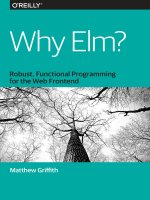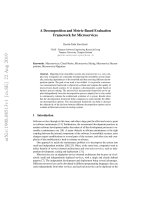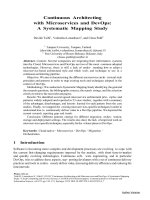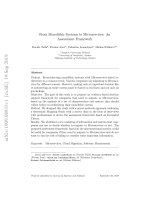IT training 1909 03249 khotailieu
Bạn đang xem bản rút gọn của tài liệu. Xem và tải ngay bản đầy đủ của tài liệu tại đây (283.3 KB, 9 trang )
A curated Dataset of
Microservices-Based Systems
Mohammad Imranur Rahman1[0000−0003−1430−5705] , Sebastiano
Panichella2[0000−0003−4120−626X] , and Davide Taibi1[0000−0002−3210−3990]
arXiv:1909.03249v1 [cs.SE] 7 Sep 2019
1
2
CLoWEE - Cloud and Web Engineering Group.
Tampere University. Tampere. 33720, Finland
[mohammadimranur.rahman;davide.taibi]@tuni.fi
/>Zurich University of Applied Science (ZHAW), Zurich, Switzerland
Abstract. Microservices based architectures are based on a set of modular, independent and fault-tolerant services. In recent years, the software
engineering community presented studies investigating potential, recurrent, effective architectural patterns in microservices-based architectures,
as they are very essential to maintain and scale microservice-based systems. Indeed, the organizational structure of such systems should be
reflected in so-called microservice architecture patterns, that best fit the
projects and development teams needs. However, there is a lack of public repositories sharing open sources projects microservices patterns and
practices, which could be beneficial for teaching purposes and future
research investigations. This paper tries to fill this gap, by sharing a
dataset, having a first curated list microservice-based projects. Specifically, the dataset is composed of 20 open-source projects, all using specific
microservice architecture patterns. Moreover, the dataset also reports information about inter-service calls or dependencies of the aforementioned
projects. For the analysis, we used two different tools (1) SLOCcount
and (2) MicroDepGraph to get different parameters for the microservice
dataset. Both the microservice dataset and analysis tool are publicly
available online. We believe that this dataset will be highly used by
the research community for understanding more about microservices architectural and dependencies patterns, enabling researchers to compare
results on common projects.
Keywords: First keyword · Second keyword · Another keyword.
1
Introduction
Microservices based architectures are based on a set of modular, independent
and fault-tolerant services, which are ideally easy to be monitored and tested
[5], and can be easily maintained [14] by integrating also user feedback in the loop
[8,3]. However, in practice, decomposing a monolithic system into independent
2
M.I. Rahman et al.
microservices is not a trivial task [19], which is typically performed manually
by software architects [14,12], without the support of tool automating the decomposition or slicing phase [14]. To ease the identification of microservices in
monolithic applications, further empirical investigations need to be performed
and automated tools (e.g., based on summarization techniques [7]) need to be
provided to developers, to make this process more reliable and effective [15].
In recent years, the software engineering community presented studies investigating the potential, recurrent, effective architectural patterns [14,15] and
anti-patterns [13,17,18] in microservices-based architectures. Indeed, the organizational structure of such systems should be reflected in so-called microservice
architecture patterns, that best fit the projects and development teams needs.
However, there is a lack of public repositories sharing open sources projects
microservices patterns and practices, which could be beneficial for teaching purposes and future research investigations.
This paper tries to fill this gap, by sharing a dataset, having a first curated list of open-source microservice-based projects. Specifically, the dataset is
composed of 20 open-source projects, all using specific microservice architecture
patterns. Moreover, the dataset also reports information about inter-service calls
or dependencies of the aforementioned projects. For the analysis, we used two
different tools such as (1) SLOCcount and (2) MicroDepGraph. The microservice dataset [9] and analysis tool [10] are publicly available online, and detailed
in the following sections.
At the best of our knowledge only M´arquez and Hastudillo proposed a dataset
of microservices-based projects [6]. However, their goal was the investigation of
architectural patterns adopted by the microservices-based projects, and they did
not provided dependency graphs of the services.
We believe that this dataset will be highly used by the research community for understanding more about microservices architectural and dependencies
patterns, enabling researchers to compare results on common projects.
Paper structure. In Section 2, we discuss the main background of this
work, focusing on the open challenges concerning understanding an analyzing
microservices-based architectures. In Section 3, we discuss the projects selection
strategy, while in Section4 are described the data extraction process (describing
the tools used and implemented for it) and the generated data. Finally, Section
6 and Section 7, discuss the main threats of concerning the generation of the
generated dataset, concluding the paper outline future directions.
2
Background
In recent years, the software industry especially the enterprise software are
rapidly adopting the Microservice architectural pattern. Compared to a serviceoriented architecture, the microservice architecture is more decoupled, independently deployable and also horizontally scalable. In microservices, each service
can be developed using different languages and frameworks. Each service is deployed to their dedicated environment whatever efficient for them. The commu-
A curated Dataset of Microservices-Based Systems
3
nication between the services can be either REST or RPC calls. So that whenever
there is a change in business logic in any of the services others are not affected
as long as the communication endpoint is not changed. As a result, if any of
the components of the system fails, it will not affect the other components or
services, which is a big drawback of monolithic system [4]. The clear separation
of tasks between teams developing microservices also enable teams to deploy
independently. Another benefit of microservices is that the usage of DevOps is
simplifies [16]. The drawback, is the increased initial development effort, due to
the connection between services [11].
As we can see in Figure 1, components in monolithic systems are tightly
coupled with each other so that the failure of one component will affect the whole
system. Also if there are any architectural changes in a monolithic system it will
affect other components. Due to these advantages, microservice architecture is
way more effective and efficient than monolithic systems. Instead of having lots of
good features of microservice, implementing and managing microservice systems
are still challenging and require highly skilled developers [1].
Products
Recommender
Central logging
Ac
co
un
ts
Ac
co
un
ts
Accounts
Service
Ac
co
un
ts
Ac
co
un
ts
Central monitoring
Accounts Service
Data
Access
Orders
Monolithic System
Database
API
Gatway
Products Services
Recomm.Services
Message
Broker
Orders Services
Microservices-based System
Fig. 1: Architectures of Monolithic and Microservices systems
3
Project Selection
We selected projects from GitHub, searching projects implemented with a microservicebased architecture, developed in Java and using docker.
The search process was performed applying the following search string:
"micro-service" OR microservice OR "micro-service"
filename:Dockerfile language:Java
Results of this query reported 18,639 repository results mentioning these
keywords.
We manually analyzed the first 1000 repositories, selecting projects implemented with a microservice-architectural style and excluding libraries, tools to
support the development including frameworks, databases, and others.
4
M.I. Rahman et al.
Table 1: The projects in the dataset
Project Name
Consul demo
CQRS microservice application
E-Commerce App
EnterprisePlanner
eShopOnContainers
FTGO - Restaurant Management
Lakeside Mutual Insurance Company
Lelylan - Open Source Internet of Things
Microservice Architecture for blog post
Microservices book
Open-loyalty
Pitstop - Garage Management System
Robot Shop
Share bike (Chinese)
Spinnaker
Spring Cloud Microservice Example
Spring PetClinic
Spring-cloud-netflix-example
Tap-And-Eat (Spring Cloud)
Vehicle tracking
Project Repository
#Ms. KLOC #Commits #Dep. Project Type
/>5
2.343
78
4
Demo
/>7
1.632
86
3
Demo
/>7
0.967
20
4
Demo
/>5
4.264
49
2
Demo
/>25
69.874
3246
18
Demo
/>13
9.366
172
9
Demo
/>8
19.363
12
7
Demo
/>14
77.63
2059
11
Industrial
/>9
1.536
90
7
Demo
/>6
2.417
127
5
Demo
/>5
16.641
71
2
Industrial
/>13
34.625
198
9
Demo
12
2.523
208
8
Demo
/>9
3.02
62
6
Demo
/>10
33.822
1669
6
Industrial
/>10
2.333
35
9
Demo
/>8
2.475
658
7
Demo
/>9
0.419
61
6
Demo
/>5
1.418
35
4
Demo
/>8
5.462
116
5
Demo
Then, we created a github page to report the project list [9] and we opened
several questions on different forums3 4 . Moreover, we monitored replies to similar questions on other practitioners forums5 6 7 8 to ask practitioners if they were
aware of other relevant Open Source projects implemented with a microservicearchitectural style. We received 19 replies from the practitioners’ forums, recommending to add 6 projects to the list. Moreover, four contributors send a pull
request to the repository to integrate more projects.
In this work, we selected the top 20 repositories that fulfill our requirements.
The complete list of projects is available in Table 1 and can be downloaded
from the repository GitHub page [10].
3
4
5
6
7
8
ResearchGate.
/>Open_Source_project_that_migrated_form_a_monolithic_architecture_to_
microservices
Stack Overflow -1 />Stack Overflow -2 />Stack Overflow -3 />Quora
-1
/>Quora -2 />
A curated Dataset of Microservices-Based Systems
4
5
Data Collection
We analyzed different aspects of the projects. We first considered the size of the
systems, analyzing the size of each microservices in Lines of code. The analysis
was performed by applying the SLOCCount tool9 .
Then we analyzed the dependencies between services by applying the MicroDepGraph tool [10] developed by one of the authors.
4.1
SLOCcount
SLOCcount is an open source tool for counting the effective lines of code of an
application. It can be executed on several development languages, and enable to
quickly count the lines of code in different directories.
4.2
MicroDepGraph
MicroDepGraph is our in-house tool developed for detecting dependencies and
plot the dependency graph of microservices.
Starting from the source code of the different microservices, it analyzes the
docker files for service dependencies defined in docker-compose and java source
code for internal API calls. The tool is completely written in Java. It takes two
parameters as input: (1) the path of the project in the local disk and (2) the
name of the project
We chose to analyze docker-compose files because, in microservices projects,
the dependencies of the services are described in the docker-compose file as
configuration. As the docker-compose is a YML or YAML file so the tool parses
the files from the projects. MicroDepGraph first determines the services of the
microservices project defined in the docker-compose file. Then for each service,
it checks dependencies and maps the dependencies for respective services.
Analyzing only the docker-compose file does not give us all relationships
of the dependencies, as there might be internal API call, for example, using a
REST client. For this reason, we had to analyze the java source code for possible
API calls to other services. As we are analyzing Java microservices project, the
most commonly used and popular framework for building microservices in java
is Spring Boot. In spring boot the API endpoints for services are configured and
defined using different annotations in java source code. So we targeted these
annotations when parsing java source code. First, we determined the endpoints
for each service by parsing the java source code and looking for the annotations that define the endpoints. For parsing Java source code we used an open
source library called JavaParser10 . After getting endpoints for each service we
searched whether there are any API calls made from other services using these
endpoints. Then if there is an API call of one service from another, we map it
as a dependency and add it to our final graph. After finding all the mapping the
9
10
SLOCcount. />JavaParser. />
6
M.I. Rahman et al.
tool then makes relationships(dependencies) between the services and draws a
directed graph.
Finally, it generates a graph representation formatted as GraphML file, a
neo4j database containing all the relationships and an svg file containing the
graph.
Figure 2 shows an example of the output provided by MicroDepGraph on
the project ”Tap And Eat”.
5
Dataset production and Structure
For each project, we first cloned the repository. Then we executed SLOCcount
independently on each project to extract the number of lines of code. Then we
executed MicroDepGraph to obtain the dependencies between the microservices.
From MicroDepGraph we got GraphML and svg file for each project. To generate
GraphML file we used Apache TinkerPop11 graph computing framework. The
GraphML file is easy to use xml based file where we can specify directed or
undirected graphs and different attributes to the graph. Moreover, we can import
the GraphML file in different graph visualization platforms like Gephi12 . In this
kind of graph visualization tools we can then apply different graph algorithms
for further analyzing the graph. We also get SVG image as output so that it can
be easily used for further processing.
Finally, we stored the results in a Github repository [9] as graphml files,
together with the list of analyzed microservice projects. Below is an output of
one of the projects analyzed by MicroDepGraph including the GraphML output,
Fig. 2: Dependency graph
1
2
<? xml version = " 1.0 " encoding = " UTF -8 " ? >
< graphml xmlns = " http: // graphml . graphdrawing . org / xmlns "
xmlns:xsi = " http: // www . w3 . org /2001/ XMLSchema - instance "
xsi:schemaLocation = " http: // graphml . graphdrawing . org / xmlns
\ protect \ vrule width0pt \ protect \ href { http: // graphml .
graphdrawing . org / xmlns /1.1/ graphml . xsd }{ http: // graphml .
graphdrawing . org / xmlns /1.1/ graphml . xsd } " >
11
12
Apache TinkerPop />Gephi />
A curated Dataset of Microservices-Based Systems
3
4
5
6
7
8
9
10
11
12
13
14
15
16
17
18
19
20
21
22
23
7
< key id = " edgelabel " for = " edge " attr . name = " edgelabel " attr .
type = " string " / >
< graph id = " G " edgedefault = " directed " >
< node id = " stores " / >
< node id = " configserver " / >
< node id = " accounts " / >
< node id = " customers " / >
< node id = " prices " / >
< edge id = " stores -& gt ; configserver " source = " stores "
target = " configserver " label = " depends " >
< data key = " edgelabel " > depends </ data >
</ edge >
< edge id = " accounts -& gt ; configserver " source = " accounts "
target = " configserver " label = " depends " >
< data key = " edgelabel " > depends </ data >
</ edge >
< edge id = " customers -& gt ; configserver " source = " customers
" target = " configserver " label = " depends " >
< data key = " edgelabel " > depends </ data >
</ edge >
< edge id = " prices -& gt ; configserver " source = " prices "
target = " configserver " label = " depends " >
< data key = " edgelabel " > depends </ data >
</ edge >
</ graph >
</ graphml >
Listing 1.1: GraphML file
License. The dataset has been developed only for research purposes. It includes data elaborated and extracted from public repositories. Information from
GitHub is stored under GitHub Terms of Service (GHTS), which explicitly allow
extracting and redistributing public information for research purposes13 .
The dataset is licensed under a Creative Commons Attribution-NonCommercialShareAlike 4.0 International license.
6
Threats to Validity
We are aware that both SLOCcount and MicroDepGraph might analyze the
projects incorrectly under some conditions. Moreover, regarding SLOCcount we
analyzed only the Java lines of code. We are aware that some project could contain also code written in other language or that the tool could provide incorrect
results.
Another important threat is related to the generalization of the dataset. We
selected the list of projects based on different criteria (see Section 3). Moreover,
several projects are toy-projects or teaching examples and they cannot possibly
13
GitHub Terms of Service. goo.gl/yeZh1E Accessed: July 2019
8
M.I. Rahman et al.
represent the whole open-source ecosystem. Moreover, since the dataset does not
include industrial projects, we cannot make any speculation on closed-source
projects.
7
Conclusion
In this paper, we presented a curated dataset for microservices-based systems.
To analyze the microservices projects we developed a tool(MicroDepGraph) to
determine the dependencies of services in the microservices project.
We analyzed 20 open source microservice projects which include both demo
and industrial projects. The number of services in the projects ranges from 5 to
25. To analyze dependencies we considered docker and internal API calls. Due
to the docker analysis, this tool can analyze any microservice system that uses
docker environment regardless of programming languages or frameworks. But for
the API call, it will only analyze the projects implemented using Spring framework. As Spring framework is widely used for developing microservice systems.
The output of the tool will allow researchers as well as companies to analyze
the dependencies between each service in microservice project so that they can
improve the architecture of the system. The output contains both GraphML and
SVG file for further analysis.
We are planning to extend the tool so that it can analyze microservices developed in any framework and programming language. Also, we can use machine
learning approach to identify different parameters and anomalies in the architecture of microservice systems. Moreover, we are planning to calculate quality
metrics for microservices, based on [20,2]
References
1. Balalaie, A., Heydarnoori, A., Jamshidi, P.: Microservices architecture enables devops: Migration to a cloud-native architecture. IEEE Software 33(3), 42–52 (May
2016). />2. Bogner, J., Wagner, S., Zimmermann, A.: Automatically measuring the maintainability of service- and microservice-based systems: A literature review.
In: Proceedings of the 27th International Workshop on Software Measurement and 12th International Conference on Software Process and Product
Measurement. pp. 107–115. IWSM Mensura ’17, ACM, New York, NY, USA
(2017). />3143434.3143443
3. Grano, G., Ciurumelea, A., Panichella, S., Palomba, F., Gall, H.C.: Exploring
the integration of user feedback in automated testing of android applications. In:
SANER. pp. 72–83. IEEE Computer Society (2018)
4. Lewi, J., Fowler, M.: Microservices. www.martinfowler.com/articles/microservices.html
(2014)
5. Martin, D., Panichella, S.: The cloudification perspectives of search-based software
testing. In: SBST@ICSE. pp. 5–6. IEEE / ACM (2019)
A curated Dataset of Microservices-Based Systems
9
6. M´
arquez, G., Astudillo, H.: Actual use of architectural patterns in microservicesbased open source projects. In: 2018 25th Asia-Pacific Software Engineering Conference (APSEC). pp. 31–40 (Dec 2018). />7. Panichella, S.: Summarization techniques for code, change, testing, and user feedback (invited paper). In: VST@SANER. pp. 1–5. IEEE (2018)
8. Panichella, S., Sorbo, A.D., Guzman, E., Visaggio, C.A., Canfora, G., Gall, H.C.:
How can i improve my app? classifying user reviews for software maintenance and
evolution. In: ICSME. pp. 281–290. IEEE Computer Society (2015)
9. Rahman, M., Taibi, D.: Microservice dataset. />MicroserviceDataset (2019)
10. Rahman, M., Taibi, D.: Microservice dependency graph (microdepgraph). https:
//github.com/clowee/MicroDepGraph (2019)
11. Saarim¨
aki, N., Lomio, F., Lenarduzzi, V., Taibi, D.: Does Migrate a Monolithic System to Microservices Decreases the Technical Debt? arXiv e-prints
arXiv:1902.06282 (Feb 2019)
12. Soldani, J., Tamburri, D.A., Heuvel, W.J.V.D.: The pains and gains of microservices: A systematic grey literature review. Journal of Systems and Software 146,
215 – 232 (2018)
13. Taibi, D., Lenarduzzi, V.: On the definition of microservice bad smells. IEEE Software 35(3), 56–62 (2018)
14. Taibi, D., Lenarduzzi, V., Pahl, C.: Processes, motivations, and issues for migrating
to microservices architectures: An empirical investigation. IEEE Cloud Computing
4(5), 22–32 (2017)
15. Taibi, D., Lenarduzzi, V., Pahl, C.: Architectural patterns for microservices: a
systematic mapping study. 8th International Conference on Cloud Computing and
Services Science (CLOSER2018) (2018)
16. Taibi, D., Lenarduzzi, V., Pahl, C.: Continuous architecting with microservices
and devops: A systematic mapping study. In: Mu˜
noz, V.M., Ferguson, D., Helfert,
M., Pahl, C. (eds.) Cloud Computing and Services Science. pp. 126–151. Springer
International Publishing, Cham (2019)
17. Taibi, D., Lenarduzzi, V., Pahl, C.: Microservices anti-patterns: A taxonomy. Microservices - Science and Engineering. Springer. 2019 (2019)
18. Taibi, D., Lenarduzzi, V., Pahl, C.: Microservices architectural, code and organizational anti-patterns. Cloud Computing and Services Science. CLOSER 2018
Selected papers. Communications in Computer and Information Science pp. 126–
151 (2019)
19. Taibi, D., Lenarduzzi, V., Pahl, C., Janes, A.: Microservices in agile software development: a workshop-based study into issues, advantages, and disadvantages. In:
XP Workshops. pp. 23:1–23:5. ACM (2017)
20. Taibi, D., Systa, K.: From monolithic systems to microservices: A decomposition
framework based on process mining. In: 9th International Conference on Cloud
Computing and Services Science, CLOSER , 2019. Heraklion (Greece) (05/2019
2019)









